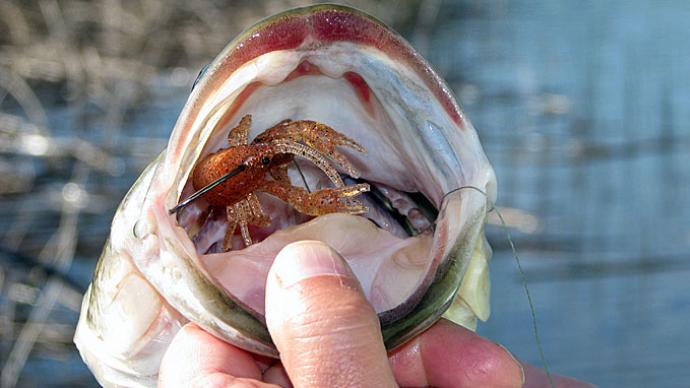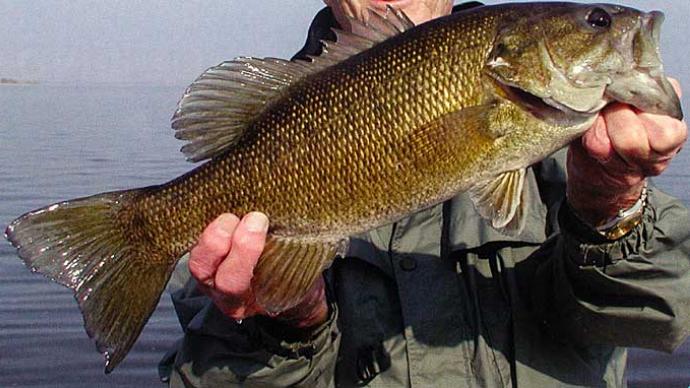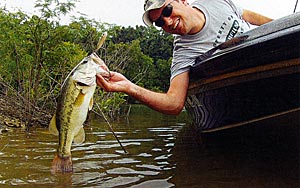
A cool breeze blows down your neck as you fish your way around the shoreline of your favorite pond. That refreshing breeze is a cool fall welcome after a long, hot summer vilified by weird weather nationwide.
Your mind is right.. .at least you think it is... as you make that next cast at a perfect target.
This summer, you rarely fished, except at dusk or during the less-hot morning hours. Now that fall has finally arrived, you are making up for lost time by taking full advantage of cooler temperatures and aggressive fish.
The same pond that was a steamy mosquito factory last summer has quickly changed into a fish hatchery loaded with trophy-sized panfish and largemouth bass.
With the change in season, approach fishing the pond differently than summer months. It's a welcome change. Fish are more active, willing to take topwater baits and fast-moving lures. As with any season, an angler has to eliminate unproductive areas...which is easier to do in farm ponds than large reservoirs. Productive areas typically have some structure or cover that fish relate to for protection and ambushing prey. Visible cover can be easily detected and fished.
Finding deeper structure requires a depth finder or using a heavy jig to feel the bottom contour.
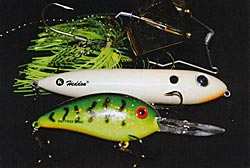
One of the most popular fish to catch in farm ponds is bluegills. These under-rated heavyweights put up a fierce battle when enticed on ultralight gear. Catch bluegill on live bait or artificial lures. But, during fall months, they are so aggressive it seems foolish to fish with anything except small artificial lures; you don't have to worry about keeping anything alive. Plus, most artificial lures can imitate any bluegill prey available during the fall period.
Toss in the fact you won't have to search hard when trying to find bluegills, and they make an ideal target for fast-paced action. One of the best places to find big 'gills on farm ponds is boat docks. Boat docks offer a place for shelter from predators and also harbors forage, including aquatic and terrestrial insects.
Besides bluegills, crappie are also a popular fish to catch during the fall. It's a fun battle fishing for crappie on ultralight gear around brush. Again, anglers could use live bait, but crappie are easily fooled into biting artificial lures when cast into the right areas. The number one artificial lure to catch crappie is a jig.
Good advice is to start with a jig that has chartreuse in it, but be willing to change if the fish refuse to bite that color. The best place to fish for crappie in the fall is around brush piles, laydowns, or wood cover. In general, crappie will be caught while suspended off the bottom. So, keep the jig from dragging by gently "popping" your rod tip to increase the number of bites you get.
Farm ponds with hybrid striped bass are excellent sources of fun fishing in the fall. Hybrids can easily be caught on topwater lures fished with conventional tackle or fly fishing gear. When fishing with conventional tackle, anglers should use topwater lures which imitate baitfish like shad or bluegills. Topwater chuggers, poppers, prop baits, or 'walking the dog' style lures will incite vicious strikes on the surface.
Although fishing for bluegills, crappie, and hybrid stripers is fun in the fall, largemouth bass are often the most sought-after fish swimming in a pond, especially in the south. Their aggressive nature heightens once the water temperature begins to cool. In addition, they are typically located in obvious visible cover and underwater structures.

Another bonus is bass will often school during this period, ganging up on schools of baitfish, and can be easily caught on topwater lures or lipless crankbaits.
When fishing for bass during the fall, anglers should constantly re-address their mindset to match the bass's activity level. This time of year, several cold fronts pass through, changing the bass activity level. Before a front moves through an area, bass will often be at their peak, aggressively feeding. Fast-moving lures like top waters, spinnerbaits, crankbaits, and lipless crankbaits, which provoke a reaction strike, will catch numbers of active bass. Once the cold front arrives, bass often become lethargic for a few days afterward, refusing to chase any lure moving too quickly. These cold, bluebird days without a breeze can be especially difficult to catch bass. Slow-moving lures like jigs or Texas-rigged soft plastics like tubes, worms, crawfish imitating, or creature-style baits are more effective than fast-moving lures. Anglers should approach each outing with this in mind; "Am I fishing before the cold front or after the cold front has moved through?" By knowing about these weather patterns, anglers can narrow their lure selection accordingly.
Which lures an angler chooses in the fall depends on what types of underwater cover and structure they are fishing. Most anglers start fishing with their favorite lure, casting randomly at cover like lily pads or laydowns. But, taking that mindset is a mistake. Consider the last cold front, think how your fish might be acting, and begin by driving or walking around the pond searching for productive areas and water clarity.
Think like this...fish often feed in a frenzy just before the front passes. Then, immediately afterward, they tend to migrate to deeper water, near structure, and suspend. After the second or third-day post front, they'll begin to change their behavior, move shallower, and feed more normally. Anglers should be on the lookout for forage that bass have available to eat. Are there any frogs, snakes, dragonfly nymphs, bluegills, minnows, or shiners around? Take special note of their color patterns and use lures that imitate those patterns. Also, look for any cover that bass may use to ambush prey or seek shelter during those bluebird days. Take mental notes where obvious cover, like lily pads, aquatic grass, laydowns, brush piles, standing timber, boat docks, and riprap is located to be fished later. Some ponds are void of any natural cover. If the pond has any artificial habitat, bass will often use it for shelter or as an ambush point. If you are fishing from a boat, use sonar to help find underwater structures. During the fall, bass migrate toward feeder creeks, so creek channels are productive during this time. Key on areas like rock piles, humps, flats, points, boulders, or ledges where bass will stack as they move towards shallower water. Baitfishes tend to school and begin migrating in the back of pockets or feeder creeks in ponds. Unlike cover, or structure that rarely moves, baitfish are constantly moving and may change locations daily depending on wind and other factors. One area an angler should fish if they find baitfish is flats. Bass often collect on flats, chasing schools of baitfish.
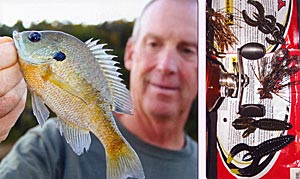
In the fall, anglers can usually catch bass all day long by using the same lure around similar cover or structure in different areas in the pond. The term for this is "pattern fishing." Pattern fishing allows the angler to fish only certain areas and lures for bass, eliminating unproductive spots. Pattern fishing is mostly used by anglers to catch numbers of bass, but this technique can also be used to catch trophy-sized bass on isolated targets.
Anglers should approach trophy bass fishing during the fall months differently compared to chasing numbers of smaller bass. Begin by searching for areas where trophy bass tend to live. Often, this is not where schools of smaller bass live. Trophy-size bass will be located around the best ambush points in the pond, but these monsters don't get big by biting anything that swims in front of them. Anglers should approach quietly, keeping a low profile from a boat or while walking the shoreline. Any cast an angler makes should be past the target cover or structure as not to spook the bass or alert it. Another key to catching trophy bass in the fall is to use big baits. Remember this...big bass have big habits. While smaller baits may catch lots of bass, an angler fishing with big baits, like 8-inch swimbaits with a hard or soft body will be more likely to attract that trophy-size bass.
Fishing ponds during the fall can be exceptionally rewarding. Compared to large, public lakes, ponds have less pressure from anglers trying to get their last trip in before winter; however, the reward of fishing a pond can be increased by fishing the right lure in productive areas. During the fall, anglers need to be aware of cold fronts moving through and where the cover or structure is located. Always be willing to change from fast moving lures to slow ones. If a bass follows the lure, but doesn't bite, change the color pattern. Just imagine that cool welcome breeze blowing as you cast your lure in the pond, anticipating a strike and catching a fish. It will get you in the right state of mind before the cold winter months ahead.
Reprinted with permission from Pond Boss Magazine


